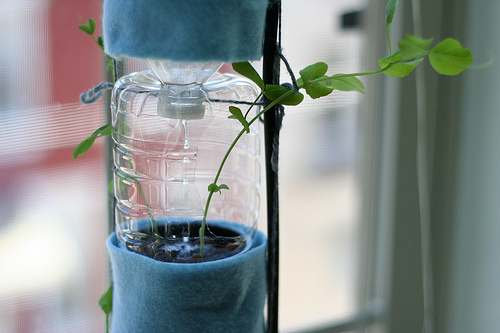It’s been a few years since I tried any hydroponics, but now that we have a place with nice big windows I’m trying my hand at a windowfarm. Windowfarms are drip planting systems that are set up vertically, making them great for places without a lot of outdoor gardening space.

Windowfarms are made from plastic bottles stacked vertically. A small airpump lifts water from the reservoir at the bottom to the topmost bottle, where it then trickles down over each plant. The plants, which were started in root plugs, are sitting in 3″ net cups filled with expanded clay pellets. The pellets offer root support for the plant, and retain water while still allowing plenty of oxygen flow.
My set up is, in a word, ugly. Eventually I plan on having four columns hanging in the window, and with any luck they’ll get more attractive as I go along.
I used a large plastic orchid pot to hide the water reservoir, which is simply an upside-down water bottle with a coil of 1/4″ tubing coming out the cap. The blue tray is leftover from a previous hydroponics experiment, and is there to hold the bottle vertically.
To make the joint between the cap and the tubing water tight, I sacrificed the barbed end of a plastic hose connector and pushed it into the cut end of the tubing. This pushes out the sides of the tubing and keeps water from escaping.
The water line is about 3 feet long and runs up to a t-joint, which you can just barely see in the photo of the reservoir. Airline tubing from the air pump comes in from the side, and the black tubing carries water up to the top of the plant column.
The basic theory of the system is that water comes up from the bottom and is then pushed up the black drip tubing by air from the air pump. Undergravel filters in aquariums work on a similar principal. Getting it to actually work is a trial and error process, and your reservoir needs to be high enough above the t-joint to keep the water pressure up.
The air pump also needed some tweaking to work well. Too much air and you get a noisy system that doesn’t lift water well, too little air and you get a quiet system that doesn’t lift water well. I found a nice four-way adjustable valve on Amazon which allows me to carefully adjust the airflow.
The system is on for 15 minutes every two hours, which I’ll increase as the plants grow. I’ve planted dwarf sugar peas, tomatoes, and basil so far. With any luck I’ll have something edible in a few months.





Great post, thanks for letting me know I have to grab a air flow valve for better control. Freezing my bottles this weekend to drill, hoping the Windowfarms kit I ordered finally comes. Been getting spotty customer service, hope they aren’t falling under the pressure. Going to enjoy watching my lunch grow here in Minneapolis, MN.
Good luck with your set-up! I’m really curious to see how everyone likes the pre-made kits when they come in, the look so much nicer than my DIY version.
One suggestion – go for a nicer flow valve than the ones they sell at PetSmart. I picked up a two-way “Top Fin” valve and had a hell of a time getting anything useful out of it. The one I got from amazon was the same price, and has much finer control.
I have a question, have you measured how much electricity is used with the pump, or do you know the wattage offhand? I’m considering this myself, but I would like to know more about the operating cost before I take action.
I haven’t measured the electrical use, but the bottom of the pump claims 1.5 watts.
Now that it’s warmer in the house I’ve increased to 15 minutes every hour during the day, and 15 / 1.5 hours at night. On cooler days like today it’s a little more frequent than necessary, but when it was 80 degrees in the house earlier this week things were drying out super fast.
In a world where I have infinite free time, setting up a system to vary the watering frequency with actual temperature / humidity would be fun.
I also have a CFL grow-light in a lamp above the setup, you can see it in the 2nd picture. It runs from 2pm to 10pm, since our window doesn’t get great light in the afternoon. It’s rated at 25 watts, and (hopefully) provides just enough extra light to keep the back of the column from getting totally sad.